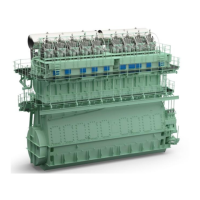Operation
0550−1/A1
Winterthur Gas & Diesel Ltd.
1/ 1
Defective Scavenge Air Cooler / Defective Auxiliary
Blowers
1. Defective Scavenge Air Cooler
When a scavenge air cooler (SAC) is defective, water can go into the scavenge air
receiver. The water then goes out through the condensate collector of the SAC drain.
The related level switch activates an alarm.
Because seawater is also used to cool the scavenge air, there is a risk that a leak can
cause bad corrosion of the air flaps, etc in the receiver.
Note: If you see water flow through the sight glass of the SAC drain when the
engine has stopped, do a check for defects as soon as possible.
If there is a fault in the SAC, it is recommended that you do the procedure given in
step 1) to step 4).
1) Replace the defective SAC with the spare as soon as possible.
Note: Step 2) is only possible with a dual-system of coolers and turbochargers.
2) Shut down and drain the defective SAC.
3) Seal the cooling water supply and return pipes of the defective SAC.
4) Open the vent and drain valves. The vent and drain valves must stay open.
Leakage water that goes into the receiver flows away through the drain pipes of the
SAC and water separator into the collection pipe.
During operation in this mode, the scavenge air temperature and exhaust gas
temperature will increase.
You can only increase the load on the engine so that the scavenge air temperature
(measured downstream of the SAC) is not more than the usual limit at service output.
You must continuously and carefully monitor the scavenge air temperature.
If the scavenge air temperature increase is too high, the engine speed must be
decreased (for the maximum permitted scavenge air temperature downstream of the
cooler, see 0250−2 Alarms and Safeguards).
Note: In these conditions, you can operate the engine only at approximately
25% load. In an emergency, you can seal the defective SAC pipes (see the
Maintenance Manual 6606-1 Locating and sealing of leaking cooler tubes
in service)
2. Defective Auxiliary Blowers
If one of the auxiliary blowers becomes defective, you can start and operate the
engine. At less than full load, there will be more exhaust smoke.
If the two auxiliary blowers become defective, the engine cannot start.
Operation during Unusual Conditions
2014

